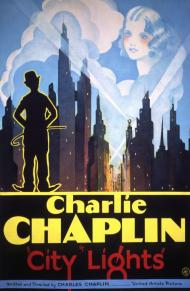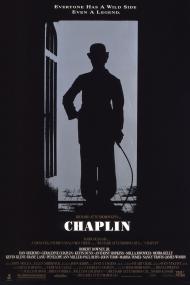Movie Review
Modern Times
Laugh . . . Cry and Thrill To his Genius . . !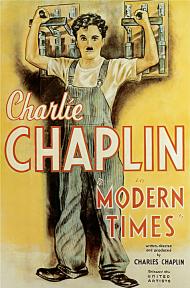
US Release Date: 02-25-1936
Directed by: Charles Chaplin
Starring▸▾
- Charles Chaplin, as
- A Factory Worker
- Paulette Goddard, as
- A Gamin
- Henry Bergman, as
- Cafe Proprietor
- Tiny Sandford, as
- Big Bill
- Chester Conklin, as
- Mechanic
- Hank Mann as
- Burglar
![3.5 star[s] out of 4](http://www.threemoviebuffs.com/static/images/global/featured_gold_stars.png)
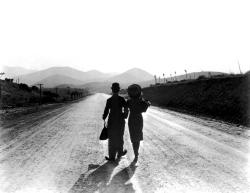
The Little Tramp and his girl head off into movie history.
The year was 1936 and the movies had been talking for the better part of a decade when Modern Times was released. This was Chaplin’s first movie in 5 years and silent movies had become an old-fashioned relic from an earlier time, akin to the horse & buggy in the age of the automobile. Modern Times, though it does contain a few lines of spoken dialogue, some sound effects and even a gibberish musical number performed by the star, is essentially a silent movie - complete with title cards.
Chaplin instinctively knew the Little Tramp should never speak on film and he didn’t. Although he would don the iconic baggy pants, hat, cane and mustache one more time as a Jewish barber in his first all talking picture The Great Dictator, Modern Times marks the Little Tramp's true swan song. By 1936 Chaplin had been world famous for more than 2 decades and at 46 he was still in great physical shape as he demonstrates in a scene where he takes an early morning swim.
Incredibly Chaplin’s artistry as a silent filmmaker was still improving. In fact his 2 best films were released during the talking era, City Lights and Modern Times. City Lights represents his peak moment of screen pathos while Modern Times is his most consistently funny movie. The pacing of Modern Times is particularly sublime. It moves effortlessly from funny sight-gag to funny sight-gag and Chaplin never overworks a joke.
It begins with Chaplin working at a factory as a bolt tightener. The opening scenes satirizing the modern machine age are the most famous of the movie. Nearly everyone has seen the image of the Little Tramp caught in those giant surreal cogs like a reel of film being spooled through a movie projector. Or the mechanical eating sequence where the ear of corn spins out of control. All of which leads to a nervous breakdown and the Little Tramp losing his job.
Next, in a clever sight gag, he gets falsely accused of being a communist and goes to jail. After a few prison escapades he gets released and fails at every job he tries. The scene where he works construction on a ship being built is perfection in its simplicity. Eventually he crosses paths with a young homeless woman (Paulette Goddard) as she is attempting to steal a loaf of bread and the rest of the movie consists of them trying to make their way in life together.
At one point they stay in a shack that is literally rotting out from under them. To appease the censors Chaplin is shown sleeping in a separate area of the shack but it was still probably shocking to some audience members to see a man and woman, who so clearly have romantic feelings for each other and that aren’t married, cohabitate.
Despite the many obstacles and setbacks faced by the Little Tramp and his female companion, Modern Times has a decidedly optimistic attitude. It is full of whimsy. With a bit of luck the Little Tramp gets a job as a night watchman at a department store. He and the girl have the run of the place and on the spur of the moment decide to roller skate. Chaplin puts on a blindfold and skates gracefully around, unknowingly coming within inches of toppling over the edge of a stairwell. It ranks as one of the most purely enjoyable few minutes from any of his movies.
The last big set piece takes place in a fancy restaurant that has hired Chaplin and the girl; she as a dancer and he as a singing waiter. After making a complete mess of waiting tables Chaplin performs a comic number with exuberant hilarity. We actually hear his voice but he is singing nonsensical lyrics while dancing an incredibly funny jig. Just when things are looking up however, once again fate steps in and the job doesn’t end well.
Cut to the final scene. The title card reads simply: Dawn. As Chaplin’s composition “Smile” underscores the scene we see a familiar looking road heading off towards some distant hills. The Little Tramp, with his pack on the end of his cane, sets off towards the unknown distance. Only this time he isn’t alone, he has his girl on his arm and a spring in his step. Slow fade to black…
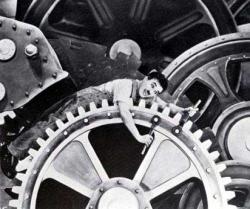
Charlie Chaplin in Modern Times.
I've enjoyed some of Chaplin's films, but I'm not a particular fan of his or of silent films in general. Your description of this movie Patrick, made me curious to see it anyway. I definitely enjoyed portions of it and you can see that this is Chaplin putting his many years of silent filmmaking experience to good use. There are moments of brilliance. However, the story is really just a series of adventures. You could easily break it up into a series of shorts.
The opening scene in the factory is by far the best. You can see elements in it that would influence everyone from George Orwell to Lucille Ball. It's also fairly political as Chaplin is clearly making a point about Depression era industry and the dehumanization of modernization. Although it's not just the capitalists who are poked fun of, as later he pokes fun of unionists when a mere five minutes after returning to work at a factory, the workers decide to go on strike again.
While the opening scene was clearly influential and the scene of Chaplin and Goddard roller skating in the store would be imitated in 1991's far, far inferior Career Opportunities, the scene in the shack actually reminded me of a Buster Keaton short with its gimmicky set.
There are several moments that I was surprised to see in a post Code movie. At the beginning when the Tramp is suffering his nervous breakdown, he can't stop trying to tighten things with his wrenches. He runs outside the factory where a woman is passing with buttons shaped liked nuts right in the middle of each breast. the Tramp advances with wrenches at the ready, only to have the woman flee the scene. Later when the Tramp is in prison, he advertantly eats and snorts some cocaine, something that was outright forbidden to be shown by the Hayes Code. While in the department store overnight, Goddard is modeling a fur coat and it appears that she's not wearing anything underneath it. She flashes the Tramp and then we see that she is in fact dressed underneath it. Were the censors more lax because this was Chaplin or because it was a silent movie?
Although I agree that the Tramp should never speak, I think making this movie a mostly silent one was a mistake. The inclusion of some spoken dialogue along with title cards just seems as if Chaplin couldn't make up his mind which kind of movie he was making. Why not make it a full-on talkie, but refrain from having the Tramp speak?
Without question there are moments of pure genius contained in this movie, but as a cohesive 80 minute story, it's lacking a bit. It really is a series of set pieces, some brilliant, some just so-so. I do agree though that the ending is perfect.
![3.5 star[s] out of 4](http://www.threemoviebuffs.com/static/images/global/featured_gold_stars.png)
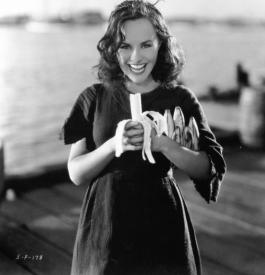
Paulette Goddard enjoys a banana in Modern Times
Modern Times is an indictment on the society of the times. The first few decades of the 20th century were notorious for harsh working conditions in factories. The eating machine is intended to maximize the workforce by not having to let them stop to take a lunch break. The big boss is only shown sitting at his desk or barking at his employees. The machinery in the early scenes as well as the ones with Chester Conklin show industrial machinery as big scary threatening beasts that can swallow you whole.
It is not only big business that gets slammed by Chaplin, but the unions take a hit as well. Scott mentioned the scene where just after getting a job he desperately wants and needs, he has to go on strike because the union says so. Chaplin is never shown intentionally supporting the union. Patrick wrote that Chaplin "...gets falsely accused of being a communist and goes to jail." The truth is the police assume he is communist because he is marching with a union, a very communist thing to do.
Modern Times shows the struggle of a country in the throes of a depression. What better character than the Tramp to speak volumes about the financial struggles of the masses? The Tramp does not want a lot. He just wants a nice little home with fruit growing into each window that he can share with his jail bait girlfriend.
Goddard plays Chaplin's underaged love interest. After her father is killed, her younger siblings are taken into wards of the court but she runs away before they can take her as well. They continue to look for her throughout the film as she is in fact under aged. This almost makes the Tramp seem slightly creepy but their relationship thankfully stays platonic. In real life Goddard married her first husband when she was only 16.
From the mass of people going to work being shown as sheep, to the struggle of a single man having problems that he has no control over, Modern Times's images speak volumes. The presence of the Tramp keeps the story personal as we see and feel for a man who just wants a job so as to have a small piece of the American dream. I just hope he waits till the homeless girl turns 18 before they marry.
Photos © Copyright United Artists (1936)

